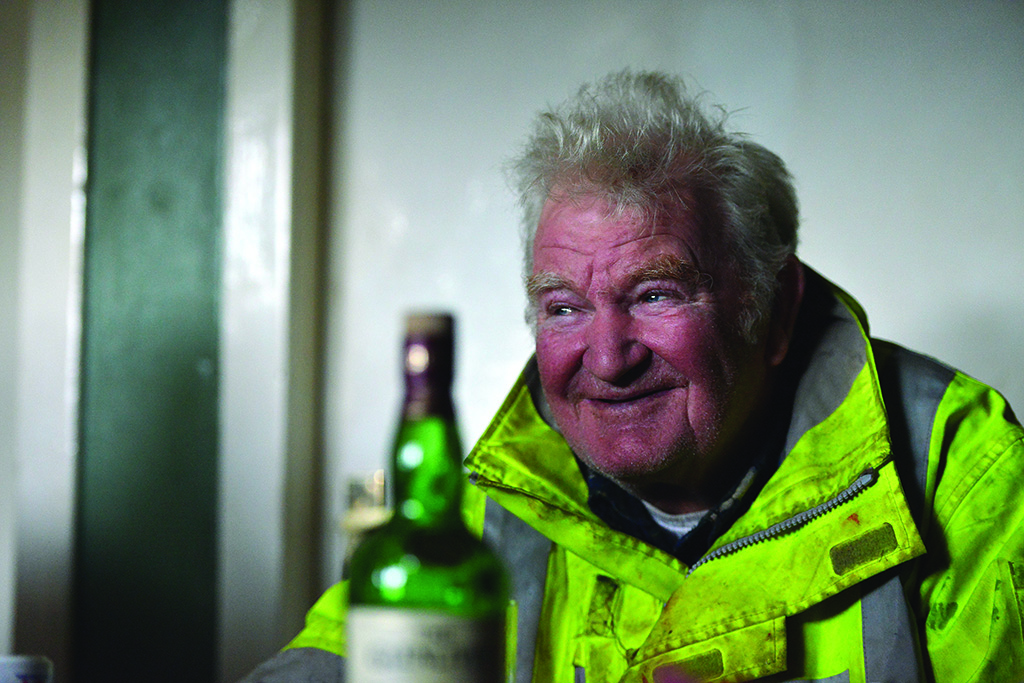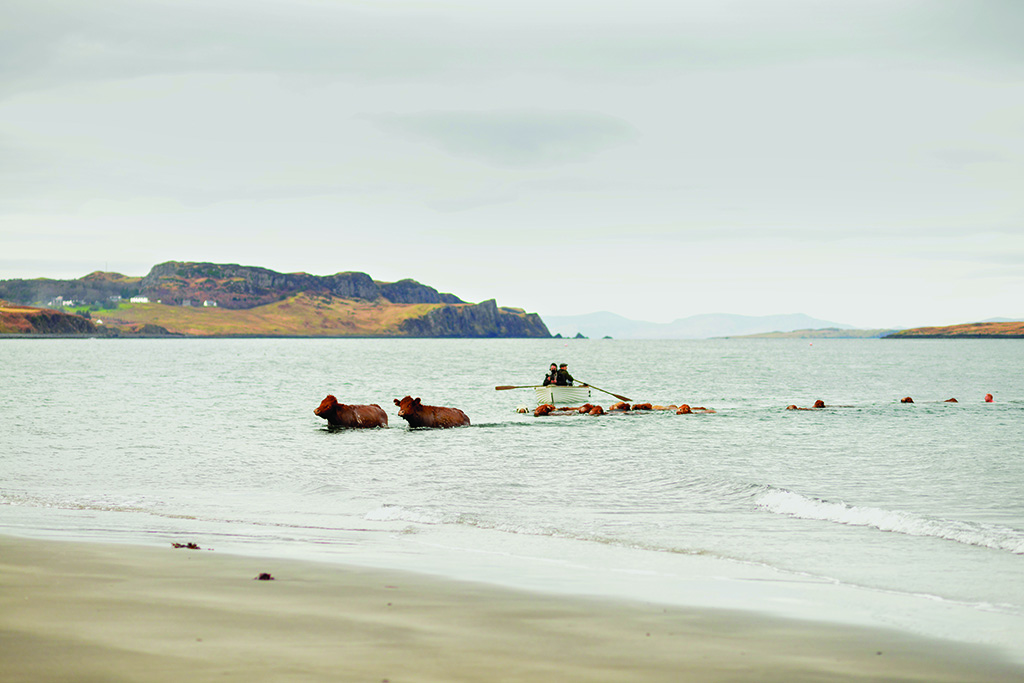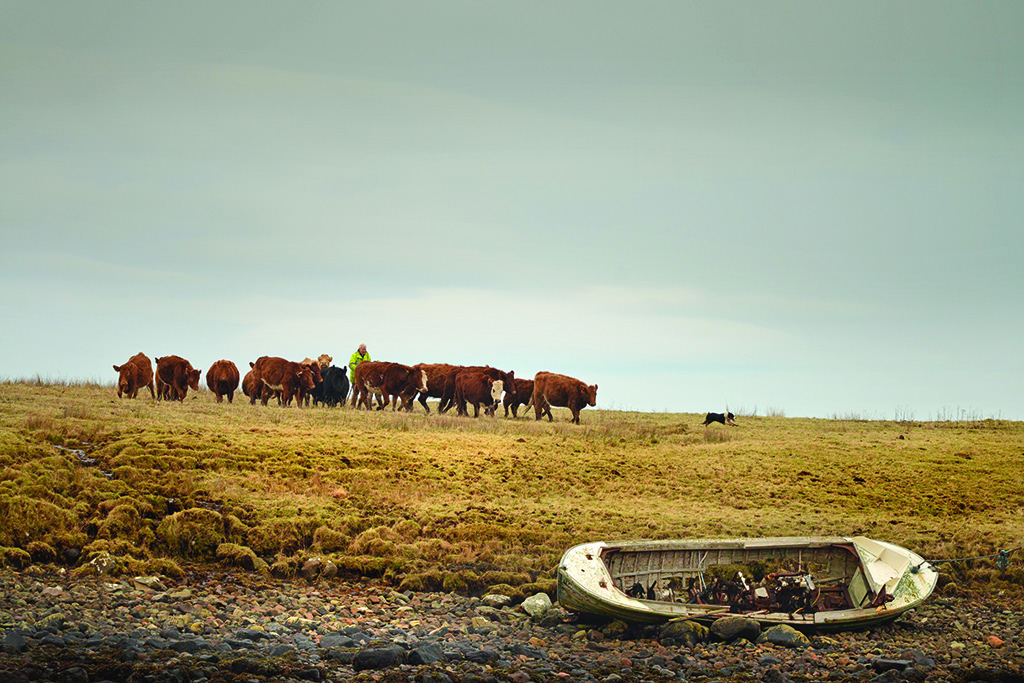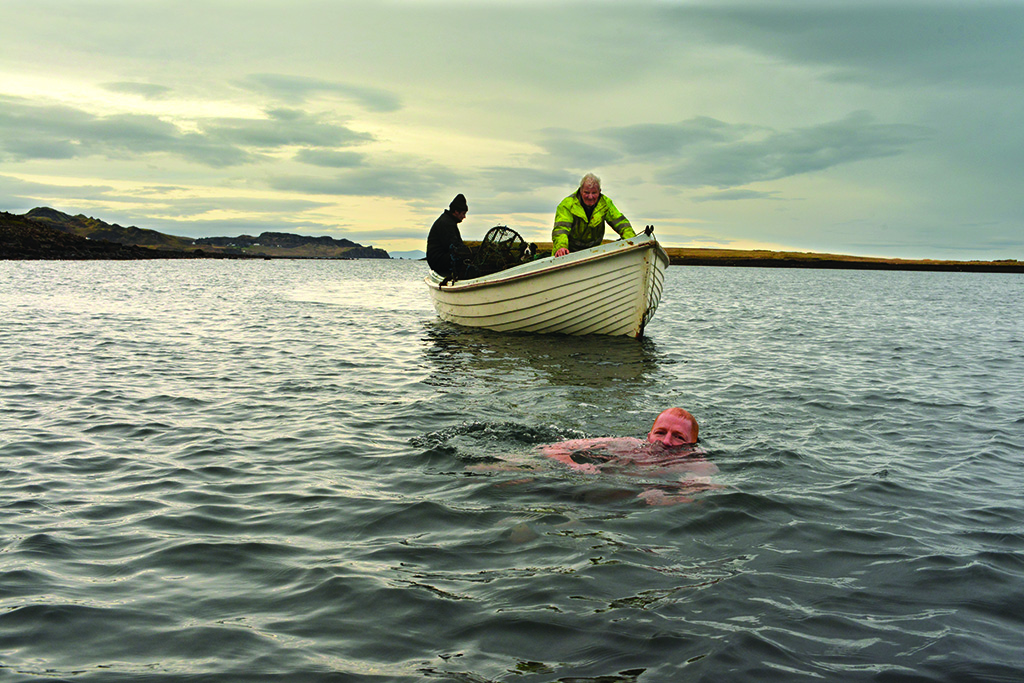Skye cattle farmers the Macdonalds maintain an ancient tradition by swimming their cows across the sea from their croft at Staffin to fresh pastures on Staffainn island.
Our man in the islands was not hard to track down. ‘Aye, that’ll be Ian Macdonald,’ said Staffin postmistress Fiona MacDonald. ‘I can see him out on his tractor.’
Sure enough, at the tip of Skye, moving towards Staffin Bay, I could see Old Macdonald feeding his Cheviots. Around him and his flock of sheep, the curiously corrugated topography of the runrigs create vivid stripes across the land.
Above our heads, a red kite wheels as the waves claw at the dark, volcanic boulders. The scene is so evocative of a bygone era that you could easily dream you’ve been transported back to a world that no longer exists.
If the brightly coloured Portree bus hadn’t trundled past, or if plastic-clad bundles of silage were not sitting in a stack, two rare nods to the modern world, you could be back in 1914.
Nor is it just the vista which endures; so, too, do the traditions. One centuries-old way of life which persists – just – is the ritual of swimming cattle to pastures new, although Macdonald, who turns 82 this month, is the last man in Scotland to do so. ‘It’s in my blood lass,’ he says, cradling a dram as he looks out of his kitchen window towards the slipway on Staffin Bay. Such is his association with cattle, he’s known locally as simply ‘The Herd’.

Ian Macdonald fuels up for the annual ritual (Photo: Angus Blackburn)
Ian, his brother, Allan, and sister, Anne, were evacuated from Motherwell to their grndparents’ Staffin croft, 27 Stenscholl, during the war. Dad, a policeman, and mum stayed on in the central belt. Ian never looked back.
This idyllic Highland childhood offered the youngster a lifelong taste of farming. ‘I pulled the short straw the first year,’ he says, as he reminisces about stripping to the waist and swimming alongside the beasts. ‘Swimming wasnae my thing,’ he laughs. ‘I frightened the hell outta the other guys when I bobbed to the surface in army troos and tackety boots.’
From that icy teenage initiation until his seventies, Ian swam with his cows every year, eventually driving them across from the safety of his boat when he became too old to get into the water. Beasts are moved from the mainland, 150 yards over the water to the lush 64 acres of Staffainn Island – in Gaelic it means ‘flat isle’ – during October.
The main croft is given a chance to recover and the cows are afforded a good winter feed. The bovine palate is varied and their particular delicacy is Canadian and Greylag goose guano, all washed down with a chaser of fresh spring water.
Each year, two days after January’s full moon, with the tide at its lowest point, the cows are then driven back across the slip to the mainland beach. Clearing the island in January allows early nesting birds such as the great skua and Arctic tern to breed in peace.

Calum Macdonald and his cows hit dry land (Photo: Angus Blackburn)
Many years ago, in slightly more dramatic fashion, island beasts were roped together by drovers and hurled into the Sound of Sleat’s surging tides at Kyle Rhea. Those surviving the heady 550-yard crossing to Glenelg on the mainland were walked on to lowland markets.
Now that there are three cattle markets in Portree each year, the long walks are gone. Yet Ian’s Limousins and Aberdeen Angus are still driven over to Staffainn because they return from their island getaway in wonderful condition.
‘They come back looking like buffalos’, says Ian’s son Calum, who helps run the croft when he’s not running his popular tearoom. Their venerable bull, who goes by the highfalutin’ name of Murray Gallant, bides his time at a neighbouring croft.
‘Only the girls get their feet wet,’ chuckles Ian, ‘Old Murray concentrates on getting the other bits wet!’
Ian took over the croft in 1958, married local lass, Katie, raised three sons and three daughters and has been moving cattle every year. He’s never lost a cow, nor has there been a refusal. ‘A good slap on the water with an oar and they know what to do,’ says Ian.
Sadly Katie recently passed away. ‘I lost my wife two years ago and miss her terribly,’ says Ian. ‘It’s the croft and the
cattle that keep me going.’
And so it comes to the big event. Staffin is usually quietly dignified, but today there’s a feverish whiff of expectation in the air. Ian, his sons Angus and Calum, friends Ally, Andy, Alan, Donald-John and half a dozen more islanders sit in Stenscholl’s tiny kitchen. Clustered together in the dim light there is much discussion of previous drives. ‘Don’t mention the red bloomers Herdy,’ calls one. He didn’t.
I ask how they know when Ian’s ‘big event’ will happen. Do they study the tide tables, moon charts perhaps? ‘Nah,’ says Ally, ‘we just phone him.’ The whisky bottle does the rounds, the shortbread stays in its packet. ‘Time for action,’ says Ian suddenly, and off he goes.

The cattle on Skye (Photo: Angus Blackburn)
A varied procession of vehicles winds its way half a mile along the single-track coastal road beneath the croft. Ian and Pip the collie ride in the 15ft wooden fishing boat, which is towed to the water by quad bike.
Across the water, ears are pricked. Seventeen beasts spy the activity and begin to line up above the now-exposed tide line. Among obsolete fishing net poles they stare balefully at the gathering horde of locals. ‘As soon as they see dad’s yellow jacket, they know what’s coming,’ says Calum.
The boats are launched. A beach has appeared, where there was none a few minutes before. A seal pops up to watch proceedings; on land four-year-old Lexie is the youngest of the spectators, her Snow White dress trailing in the water. Hamish and Jock the Shih Tzus yelp and roll. A rugby ball is passed from father to son. At exactly 1.39, lowest tide, a loud ‘come by, come by’ rings out from Ian.
A centuries old tradition has begun. The cattle start to edge down the seaweed-clad cliffs towards the choppy slipway. Either side of their route, two small boats bob. ‘It’s quite emotional,’ whispers local Scout leader Kath Bainbridge-Keith.

Calum joins in with the cattle crossing (Photo: Angus Blackburn)
With little fuss or hesitation 16 beasts and a calf sniff the water, snort and enter the sea. For seven minutes, nostrils aloft, hot breath pouring out, they glide, like a mighty beef raft, towards the beach. Young and old keep pace.
Behind them though is not just an old man doing what he knows best. There, in his shorts, in January, swimming alongside his father’s beasts is Calum Macdonald. The assembled crowd let out a collective gasp of appreciation.
This is a break with tradition and the locals know it. Nothing is said between father and son, just a nod of understanding.
The cattle emerge onto the beach. Their leader stops. She shakes, gathers her thoughts and then, like any obliging celebrity, allows snappers to get their shots.
But the real star of the day has two legs.
Quietly, and without fuss, Calum Macdonald has seen the girls safely across and ensured history will keep on repeating itself. ‘I feel proud, very proud,’ mutters Ian as he lands his boat. Old, capable hands pull at the creels. Is that a tear in the eye?
At Staffin’s MacKenzie village shop a sign reads: ‘Staffin Slipway Development meeting’ where ideas for the future are to be discussed.
I can’t help thinking that the best piece of modernisation has taken place today though. Hopefully the postmistress will have a new local hero to point out in years to come.
- This feature was originally published in 2014.
TAGS

